For a space, agent or initiative to appear on the map and in the directory, it is necessary to register in Kultursistema. Registration is free and to do so you only have to enter an email and create a password.
These will be your credentials to access whenever you want.
Once inside, you will be able to create a public profile in three steps:
At Kultursistema we want to promote the mapping of the entire Cultural and Creative Ecosystem, making as many agents as possible visible. For this reason, we regularly incorporate data obtained from public sources into our system to create files like yours.
You can take control of the file to edit or delete it in three steps:
If you do not want your data to remain in Kultursistema, you can write to hola@kultursistema.com to request the total deletion of the file and the information collected about you in the database.
No, appearing on the map and in the Kultursistema directory is free of charge. You can create for free as many accounts and cards as spaces, agents or initiatives you want to make visible.
Check if the email you are entering is correct or try resetting the password.
If the problem persists, you can contact hola@kultursistema.com and we will find a solution.
All the information you enter in Kulturisistema is automatically saved online and is always accessible to you in your account. If you change any data, it is automatically updated and replaces the previous one.
To save a history of your data, download them in pdf format by following this link: check my data.
One of the main objectives of this project is to respond to the lack of primary data on the Cultural and Creative Ecosystem. The online platform Kultursistema allows cultural and creative people and organisations to share up-to-date information on their characteristics, situation and impact. This information is analysed and interpreted in an aggregated way for its subsequent visualisation, in the form of statistics and reports, helping to define policies that are appropriate to the reality of the Ecosystem.
The data collected (some optional) are classified into three main groups:
The data you enter in Kultursistema are yours and you have the right to edit, update or delete them.
You can consult the following link for the privacy policy.
How can I consult the data about my Cultural and Creative Ecosystem?
You can consult the information on the different spaces, agents and initiatives by freely exploring the map and the directory of the Cultural and Creative Ecosystem. It is a free service accessible to all audiences.
If you are an agent of promotion, encouragement or regulation interested in advanced statistical data and sectorial or territorial reports, please contact hola@kultursistema.com and we will make you a tailor-made proposal.
The platform is online and accessible from any electronic device with your favourite browser. You don’t need to install any software or application, but you do need an internet connection to upload and view data.
Kultursistema is based at the Conexiones improbables offices in Vitoria/ Gasteiz (Euskadi, Spain).
We recommend you contact us first by writing to hola@kultursistema.com, or if you need to, by calling +34 673 608 790.
KULTURSISTEMA proposes a categorisation matrix (or set of matrices) for the mapping, interpretation and analysis of cultural and creative ecosystems.
It aims to reflect their diversity in terms of sectors and sub-sectors, links in the value chain, typology of agents involved in this field, as well as the characteristics of the fundamental impacts and returns.
KULTURSISTEMA aims to favour the richest and most up-to-date approach possible to cultural and creative ecosystems, including new agents and practices, or those that emerge from the crossing of pre-existing typologies, and which are difficult to fit into conventional frameworks of analysis. An approach that also points out the dynamic and changing nature of the cultural and creative sectors, both per se and as a result of the multiplicity of relationships with other disciplines and fields of activity, as well as the influence of technological changes, institutional frameworks of reference or social values.
KULTURSISTEMA is an effective tool for the self-diagnosis of organisations and professionals in the sector, as it helps them to define their priority fields of action and to contrast reality with the desired field of activity. It also has the vocation of being an instrument to help orientate cultural policies and/or those linked to the development of creativity in a specific territory, being able to better understand the environment of action and to decide the focus of public action.
In short, KULTURSISTEMA is useful as a reference element in the work of policymakers, teams of cultural organisations, consultants specialising in the sector and policymakers. KULTURSISTEMA helps to define the role of the different agents in the ecosystem of which they form part.
The interpretation tools offered by KULTURSISTEMA coincide in many aspects with the usual categorisations in the cultural sector, such as the concentric circles proposed by David Throsby or the UNCTAD classification, but extended by the report’s writing team and contrasted in turn with other categorisations (Agenda21 for Culture, CNAE, DCMS of the UK Government, Consejo de la Cultura de Chile, etc.), as well as with the categorisation of the cultural sector as a whole, and with the categorisation of the cultural sector as a whole. ), as well as with the categorisation used by the Basque Government in the framework of the Euskadi RIS3 Smart Specialisation Strategy.
Although KULTURSISTEMA has emerged in the territorial framework of the Basque Country, responding to some of its conjunctures and specificities, it is an instrument that can be extrapolated to other places, and contextualization work is always necessary.
Based on this conceptualisation, KULTURSISTEMA has developed a whole methodology for mapping, analysis and interpretation of cultural and creative ecosystems that is enriched by the work in the creative economy of Conexiones improbables, its owner.
The analysis of a cultural or creative ecosystem requires the identification of the greatest possible number of agents, whether they have a greater or lesser vocation to intervene in it. We propose a classification of people or groups with different objectives, with different legal natures, organisational models, dimensions or types of activity.
With regard to their main purpose, we classify the agents into three areas of action which, although we emphasise one of them, may sometimes overlap or intersect:
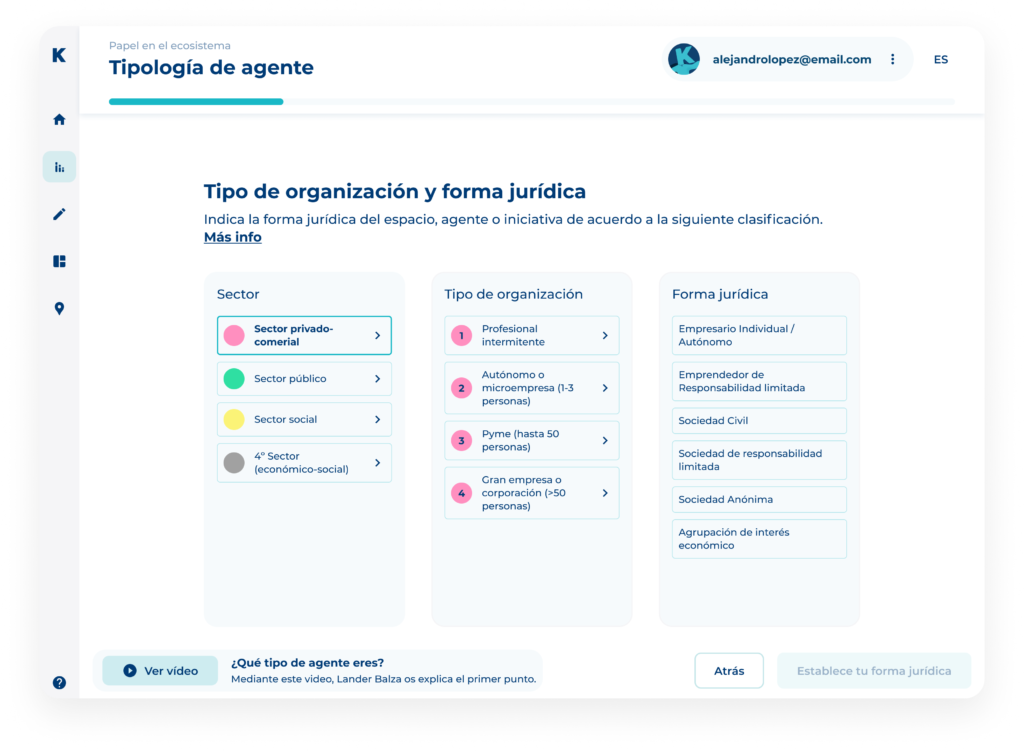
Typology screen on Kultursistema platform

Spaces and platforms (physical and virtual) for creation, production, exhibition, distribution, conservation and marketing.
Archives / Libraries / Cultural centres / Production centres / Specialised training centres / Cinemas / Co/ workings / Multi-purpose spaces / Studios and workshops / Creative factories / Art galleries / Bookshops / Maker spaces and Hacklabs / Museums / Theme and leisure parks / Repositories and digital content channels / Concert halls / Auction halls / Theatres / …

Public administrations (departments, autonomous bodies and public business entities) and private bodies, with direct or indirect competences and interests in the regulation, promotion and/or encouragement of culture, creation and creativity in different fields and levels.
Collective representation entities: Business associations / Sectorial clusters / Associative federations / Trade union organisations / Intellectual and industrial property rights management companies / …
Companies or financing entities: Sponsors / Corporate sponsorship areas / Corporate social responsibility areas / Crowdfunding platforms / Fundraising entities / Venture capital entities / Specialised sectorial funds / …

We consider here all types of individual or collective agents, natural or legal persons, who intervene directly in the market or their cultural or creative context from their field of action. For example:
Actors / Opera singers / Circus companies / Heritage restoration companies / Urban culture collectives / Graphic design studios / Associations promoting experiences in gastronomic culture / Artistic intermediary companies / Cultural mediators / Museologists / Audiovisual producers / Cultural consultants / Event organisers / Visual artists in non-artistic contexts / Novelists / Publishers / …

1. Intermittent professionals
2. Self-employment
3. SMES
4. Big companies & corporations
5. Public administrations
6. Public undertakings
7. Other public law entities
8. Individual active citizenship
9. Informal organisations
10. Associations
11. Foundations
12. Social economy enterprises
13. Professional associations
14. Clusters
15. Networks
Culture and creation are understood here as the set of areas of activity that make up and broadly affect culture. A complex reality, which incorporates anthropological, sociological, political, legal-administrative, economic-productive, etc. aspects. KULTURSISTEMA proposes a classification organised around five differentiated but interrelated sectors or levels, to which we have incorporated a cross-sector. These sectors are represented by concentric circles, giving a more germinal character to the central circles and a more instrumental character to the exterior.
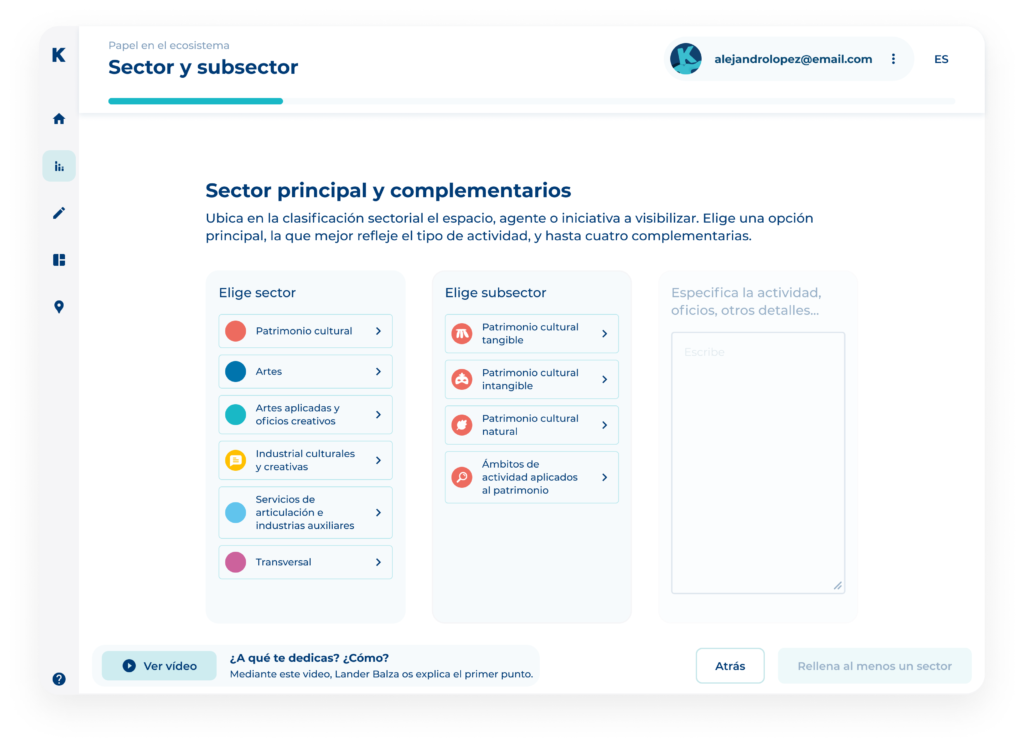
Screen of the sectors on the Kultursistema platform
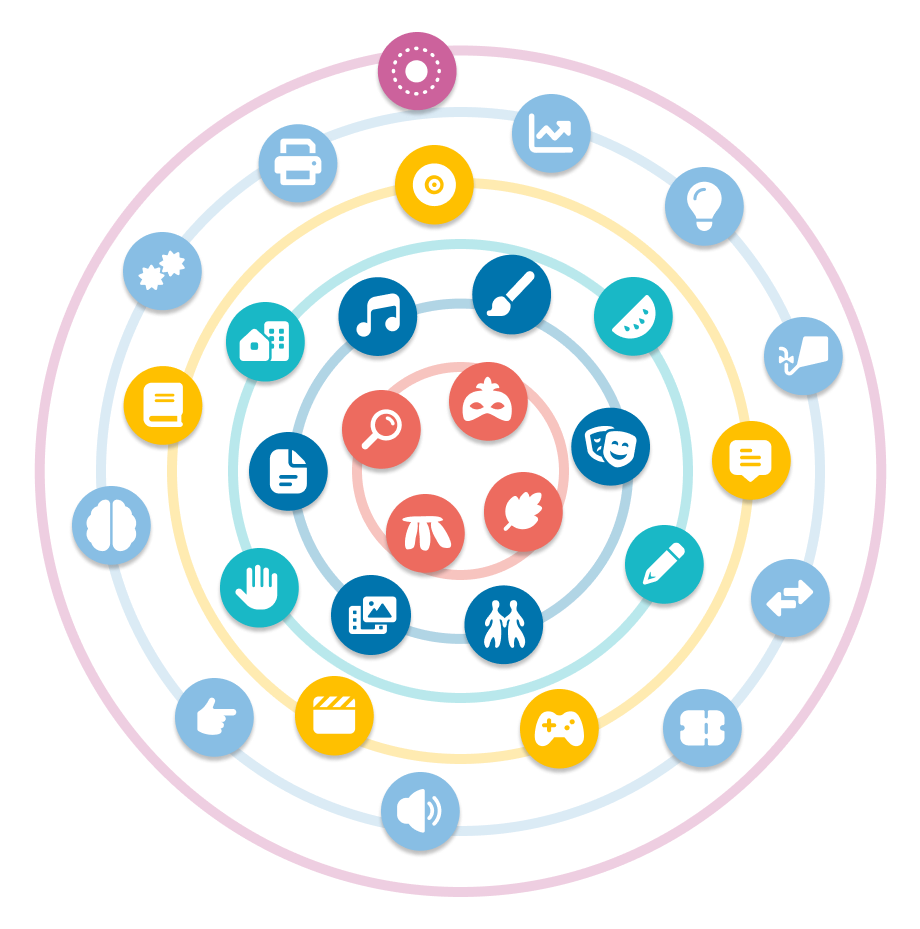
These sectors, except for the Transversal sector, are in turn subdivided into various disciplinary sub-sectors, made up of a wide range of differentiated activities, which are listed below in a non-exhaustive manner.
Regardless of the field of action (structure, impulse or creative field) or the type of agent involved, these agents can act in any of the sectors and sub-sectors.
It is important to point out, given the singularities of the sector, that the proposed categories are neither pure nor closed; that new specialised fields of activity emerge; that there are activities that cross over between one or more sectors, producing evident overlaps, some of these even with links in the cultural/creative value chain. Furthermore, it has been decided to leave out of focus sectors that are close to or have strong intersections, such as natural heritage, sport or tourism (except for the specific cultural sector).
The broad set of cultural assets, tangible and intangible, that make up the dynamic identity of a community, that represent a historical-cultural testimony and symbolism for it, and that one generation inherits and transmits to the next with the purpose of preserving, continuing and increasing this heritage, conceived as a cultural substratum for the creation of the future.

Movable (artistic, bibliographic, furniture, etc.) and immovable (monuments, buildings and sites).

Composed of traditions and living expressions, knowledge, languages, celebrations, collective memory, traditional culture.

Archaeological remains in their natural context, fossils, terrestrial and underwater, other materials of scientific opinion, as well as the cultural landscape produced in a given time and space.

Archival and library science / Archaeology / Documentation and cataloging / Historiography / Museography / Palaeontology / Restoration / ...
Sphere from which to create, compose and propose; working with diverse forms, materials, languages, expressions and relations; and producing new meanings, stories, representations, devices, symbolic spaces and subjectivities.

Comic / Essay / Screenplay / Novel / Poetry / Literary translation / ...

Classical / Choral / Contemporary / Lyric / Popular / Popular / ...

Bertsolaritza and improvisation / Circus / Dance / Performance / Magic / Theatre / ...

Animation / Audiovisual creation / Drawing / Sculpture / Photography / Engraving / Painting / ...

Electronic art / Multimedia and interactive art / Art and science / Data culture / Hardware and software for artistic experimentation / ...

Behavioral art / Community art / Artivism / Contextual practices / ...
Set of creative activities that apply knowledge and techniques of the arts, in combination with other technical disciplines, to produce utilities of a primarily functional nature.

Ceramics / Musical instruments / Jewellery / Wood / Leather goods / Textiles / Glass / ...

Maker culture / Editorial / Experiences / Graphic / Illustration / Industrial / Games and toys / Fashion / Multimedia / Process / Product / Services / ...

Ephemeral architecture / Building / Scenography / Interior design / Furniture / Landscaping / Urban planning / ...

Creative cuisine / Food culture / Gastronomic experiences / Culinary R&D / ...
Set of activities that give tangible or intangible support to cultural and creative contents and products, allowing their systematised, serialised production and mass distribution (including the services closely linked to such standard production).

Catalogues / Limited editions / Book / Press and periodicals / ...

Music production / Promoters / Record labels / ...

Film / Dubbing / Radio / Tv / Video / ...

Digital content / Digital manufacturing / Entertainment hardware and software / Educational hardware and software / Transmedia / Video games / ...

Language teaching / Language technologies / Terminology-Lexicography / Translation and interpreting / ...
A diverse set of training services, accompaniment, technical support, means of production or other specialised cultural and creative activities, often of a cross-cutting nature, aimed at the different cultural or creative sectors, as well as applied from the cultural to other fields.

Formal (formal system of education at different levels) / Non-formal (specialised training outside the formal system).

Room assistance / Facilitation - Dynamisation - Animation / Cultural guidance / Artistic mediation / Multicultural mediation / Pedagogical services / ...

Curatorship / Management and representation / Programming / …

Advertising / Public and media relations / Social media / Audience management / Ticketing / …

Congresses / Fairs / Festivals / …

Leisure activities / Cultural tourism / …

Analysis-Research / Advice and accompaniment / Creativity and innovation / Specialised legal services / …

Cultural administration / Design and management of cultural projects and organisations / Technical secretariat / …

Sector-specific financial products / Sponsorship and patronage / Microfinance and crowdfunding / Microfinance and collective investment /…

Graphic arts / Hardware, software and telecommunications / Mechanisation and industrial production / Museum production / Technical equipment and services / …

Today, many cultural and creative expressions drink, link or intermingle with others, but we incorporate this Transversal sector to expressly point to the increasing number of agents whose practices are per se of a dialogic or hybrid nature, either intracultural – between several cultural and creative sectors or sub-sectors without the dominant presence of any of them or extra cultural – developing crossings between cultural and creative sectors and sub-sectors with other disciplinary and knowledge fields – or extra cultural – developing crossings between cultural and creative sectors and sub-sectors with other disciplinary and knowledge fields.
A value chain is understood as the set of differentiated stages of value addition which, in a chain – not necessarily consecutive – manner, allow the cyclical representation of the activities required for the correct functioning of the relationship between supply and demand. The set of links is usually covered by more than one agent.
Analysing the value chain of the different cultural and creative sectors and sub-sectors, as well as knowing the position of the different organisations or professionals in it, is very useful to understand the spaces not covered, the inefficiencies, the over-presence or the opportunities offered by an environment and which are often decisive for the viability of initiatives and the development of the ecosystem as a whole.
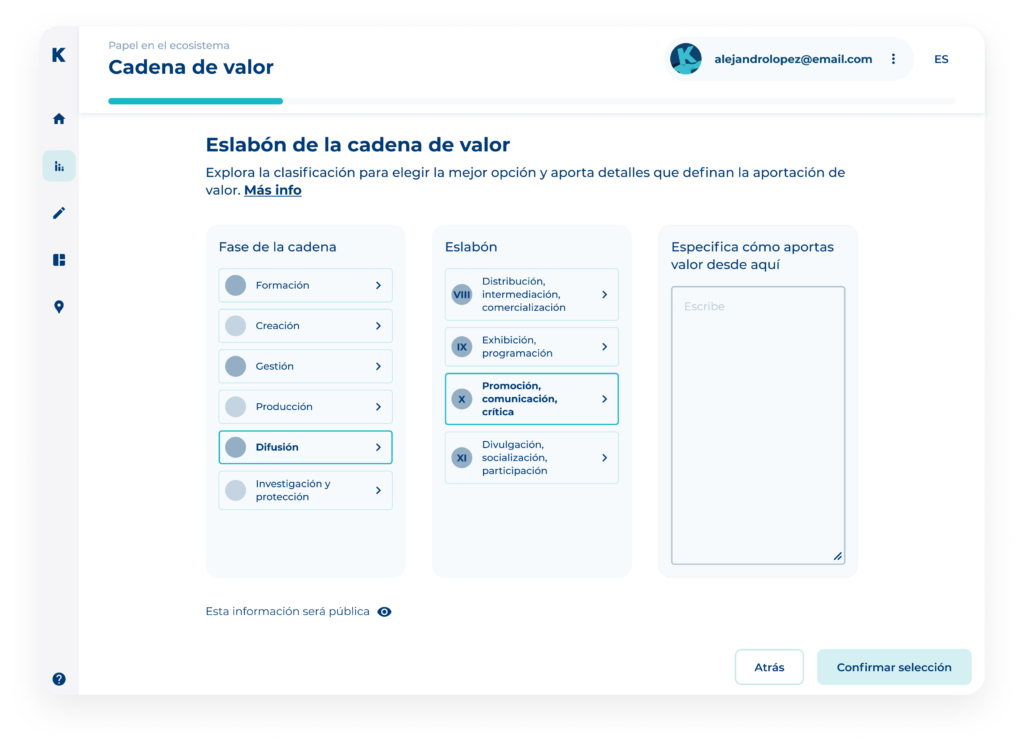
Value chain screen on Kultursistema platform
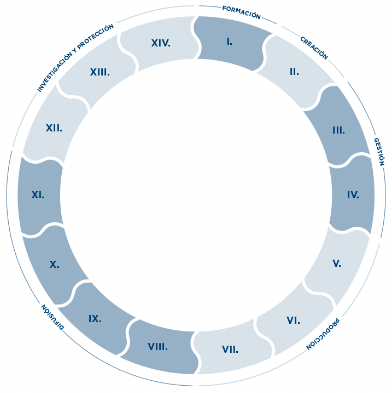
This information is key for organisations, professionals and those responsible for cultural or creative promotion policies to be able to define plans and strategies that are adequately contextualised.
Although internally every agent deploys its own value chain to carry out its purposes (offering and developing processes, products, services, experiences, etc.), in KULTURSISTEMA we pay attention to the specific position or positions that each agent occupies in the external value chain. In other words, we seek to ensure that each agent identifies its focus of activity, where its main contribution of value and meaning lies within the specific sectoral market. For example, although all agents need funding, this does not mean that they are professionally dedicated to the funding of cultural projects or organisations. Therefore, in this link we should only find those agents that finance or facilitate access to cultural funding for third parties.
In KULTURSISTEMA we have tried to bring together in a single graph the different links that make up the different value chains of the various sectors and sub-sectors. In addition, in order to be operational, we have grouped different sub-phases or functions within each link.
I. Education and training (formal and non-formal)
Development and transfer to third parties, with a professional orientation, of knowledge, methodologies, techniques, languages… related to the arts and various cultural and creative expressions or practices, within the framework of the formal education system or in non-formal educational environments.
II. Experimentation / conceptualisation / creation / interpretation
Processes of exploration, development, combination and contrast of ideas and practices in order to generate new creations or recreate pre-existing creations, generate new knowledge, new outlooks or new attitudes towards a field or expression of arts and culture or, using the latter, to influence changes and transformations in other fields or social domains.
III. Funding
Direct contribution, advice or specialised mediation in attracting or generating monetary or non-monetary resources for the development of projects and/or the daily activity of an individual or organisation in the cultural and creative ecosystem.
IV. Administration / management
V. Pre-production / prototyping
VI.Production / Post-production
VII. Industrial reproduction
VIII. Distribution / intermediation / marketingSpecialised actions of placing on the market, through physical or virtual channels, an offer of products, services, ideas or cultural and creative experiences, produced in-house or by others.
IX.Exhibition / programming
Display, presentation or exhibition of creations, productions or creative processes to a final target audience, either in isolation or as part of a performance programme.
X. Promotion / communication / critique
Actions aimed at active listening, dissemination, enhancement, persuasion and/or critical analysis of cultural and creative productions in their relationship with different target audiences.
XI.Dissemination / socialisation / participation
Facilitation actions aimed at accessibility, interaction and the generation of favourable contexts for cultural and creative practices. They promote knowledge, dialogue and mutual learning as well as the involvement of the community in cultural production as a social fact.
XII. Analysis / evaluation
Generation of tools, indices and indicators -and their application in studies of the situation and impact over time-, of cultural and creative policies, programmes, projects or actions.
XIII. Documentation / Archive
Information management tasks in order to guarantee a documentary heritage as well as to generate, share and socialise knowledge in an orderly and systematised way.
XIV. Protection / Conservation / Restoration
Activities and processes aimed at the permanence, protection and rescue of those irreplaceable original artistic and cultural manifestations, in order to favour their identification, prevent their degradation, transmit their meaning to current and future generations, as well as promote their responsible and sustainable use.
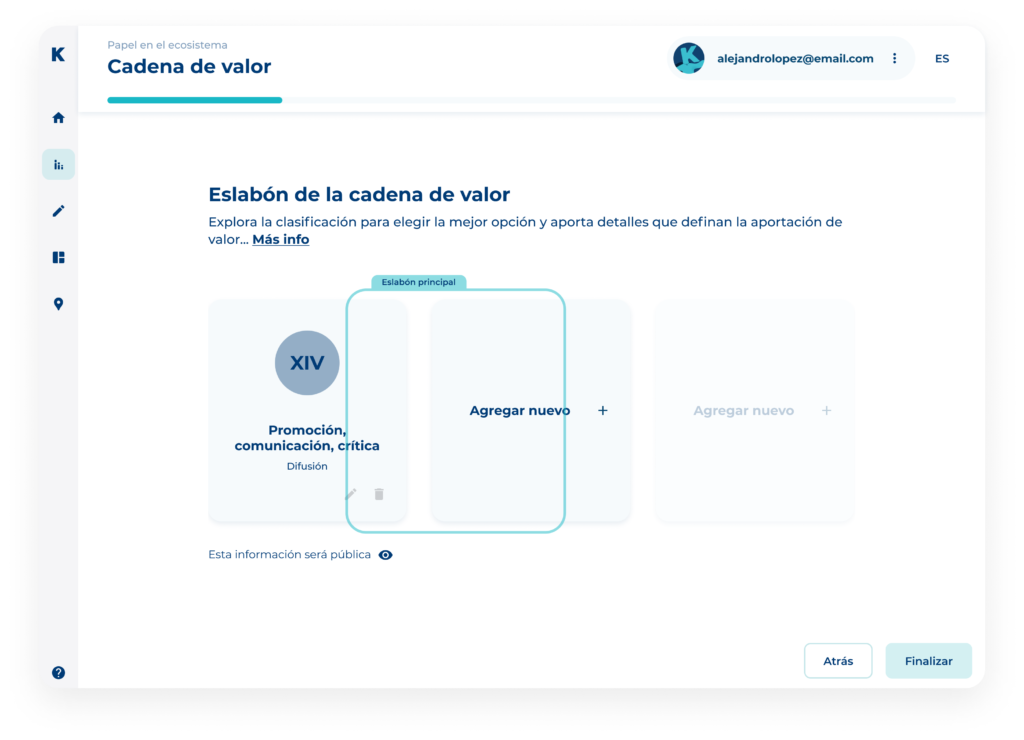
Screen of the value chain on the Kultursistema platform.
An increasing part of the power and value of the cultural and creative ecosystem is to be found in: the redefinition and repositioning of pre-existing agents; the appearance of new agents whose diversity in terms of typology, fields of activity or forms of socialisation of knowledge go beyond the usual conventions; and the possibilities for the emergence of emerging phenomena offered by their combination.
For this reason, KULTURSISTEMA, in addition to the matrices that serve to analyse separately each of the relevant aspects, proposes three complementary matrices (that cross data), helping to make a more complex and refined interpretation and to discover and pay attention to peculiarities, potentialities and opportunities, in the field of action of each agent or of a territory.
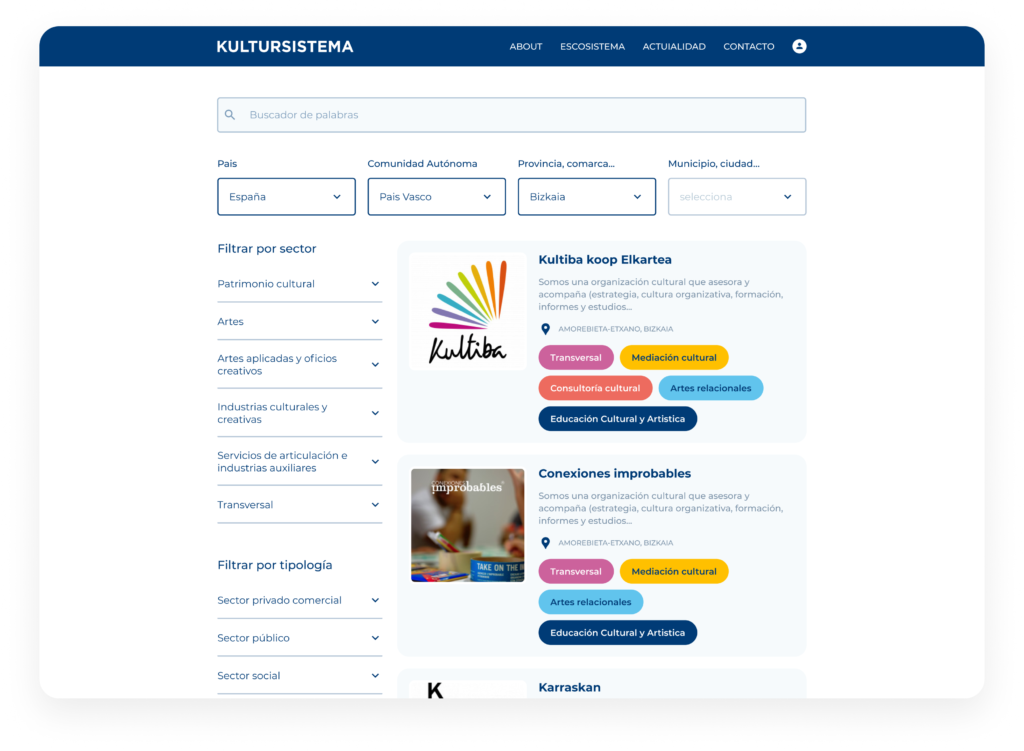
Kultursistema search engine screen
Other data of interest to generate reports and statistics on the situation of the Cultural and Creative Ecosystem. All information is treated anonymously and aggregated, with no link between the specific data and the space, agent or initiative from which it originates.
We work with approximate quantitative and qualitative values to detect patterns and trends.
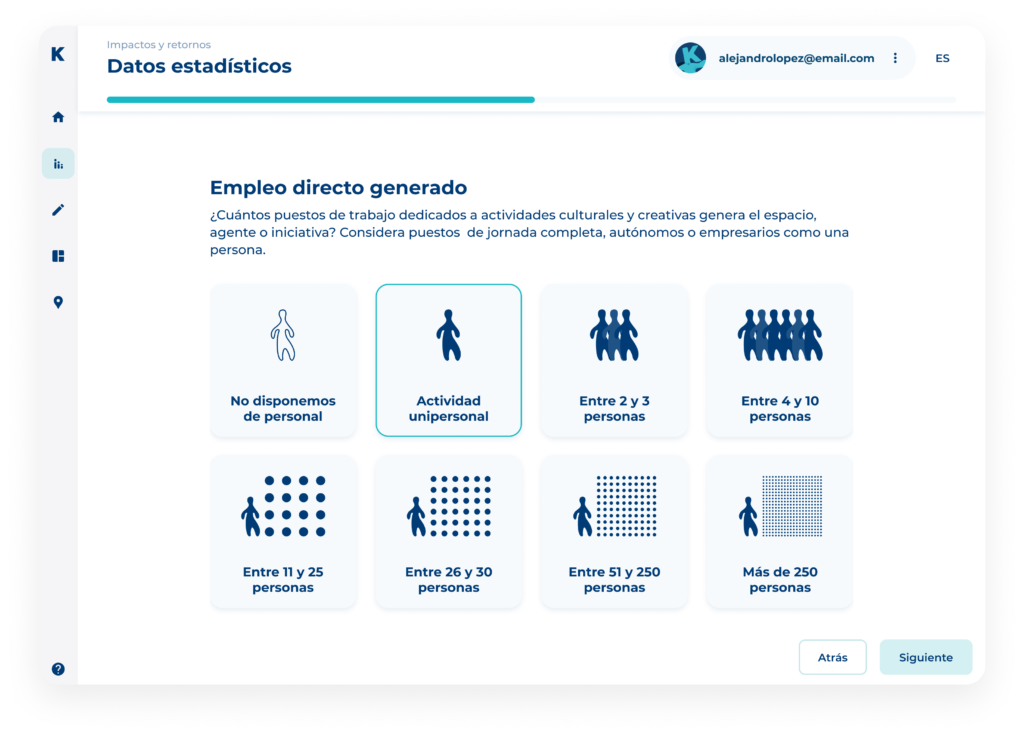
Data screen on the Kultursistema platform.
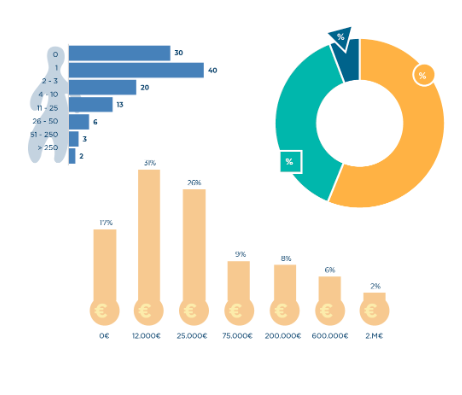
Product VS Service-experience
Concretisation of the offer or activity in tangible and intangible solutions.
Processes VS Results
The main orientation of the offer or activity based on the value proposition.
Analysis of the linguistic diversity of the Ecosystem and the relative weight of languages in the development of the activity, both for the orientation towards customers and public, as well as for internal work. The degree of use of languages is measured on a percentage basis, identifying which are the main and complementary languages.
Analysis of the orientation and geographical scope of the spaces, agents and initiatives. The areas in which it carries out its activity are marked, identifying the main area of activity.
Analysis of the capacity to generate direct and indirect employment. An approximate range of people working specifically in activities linked to the cultural and creative sectors is marked (considering the equivalent of full working days), their characteristics are detailed (job stability, gender considerations and other diversity factors) and other types of productive relationships with partners, volunteers and other professionals are identified.
Ranks of employed persons
Analysis of the economic dimension of the space, agent or initiative. An approximate range of annual turnover or budget linked to the activity is marked.
Turnover or budget ranges
Impacts and returns are understood as the expression of the effects, changes or results derived from the implementation of a specific plan, program, project, service or action on a social group, a specific area or on the process, organisation and/or agents involved.
These consequences and cause-effect relationships in the short, medium and long term can be of different types, such as: internal or external returns; specific or global; planned or unplanned; positive, negative or neutral; direct or indirect. They also depend on their quantity, quality and extent.
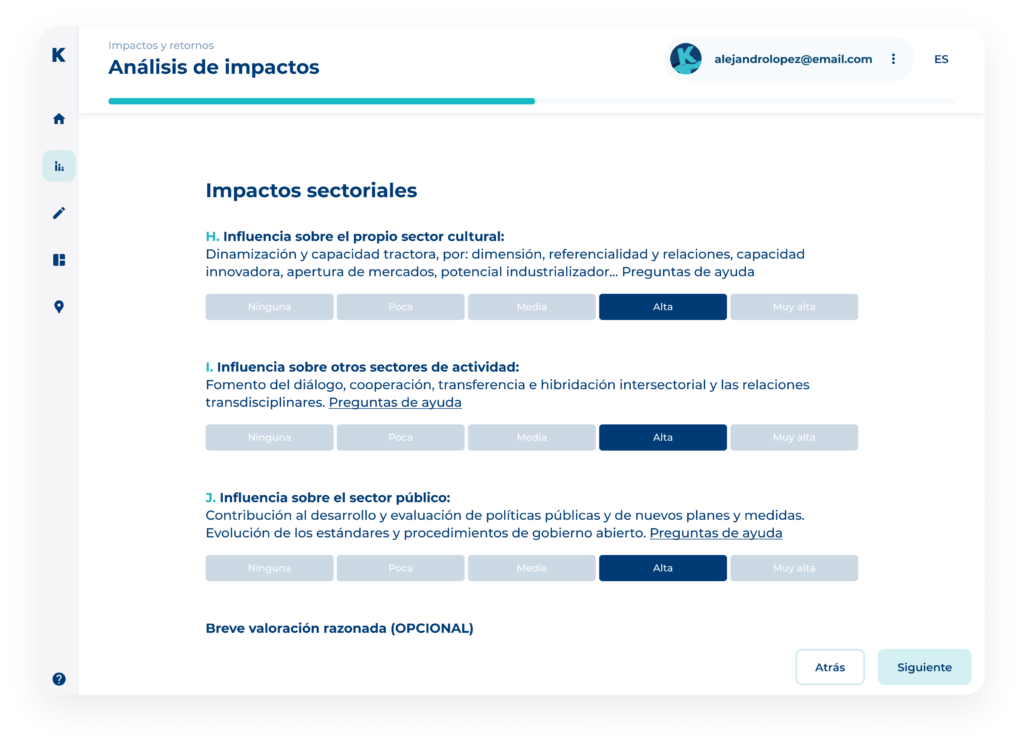
Pantalla de análisis de impactos en plataforma de Kultursistema
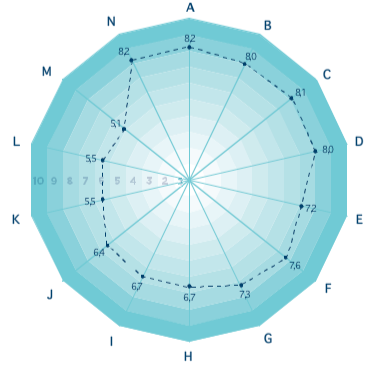
Aware of the existence of policy evaluation indicators, of indices that measure creativity and sectorial potential for territorial development or of systems for quantifying the impact of a cultural action on the local economy – to give just a few examples -, KULTURSISTEMA has developed a proposal for self-diagnosis – with a more reflective and advocativist character than quantitative analysis – composed of a battery of four indices and thirteen reference dimensions.
The effects produced in the context, on the territory, the people, their social systems and the challenges to be addressed together.
A. Creative society
Encouragement, individually and collectively, of creation and creativity, critical thinking and the production of new narratives, imaginaries and subjectivities.
B. Cultural development
Promotion of democracy and cultural democratisation. Development of culture as a right. Access to cultural production and enjoyment. Creation and qualification of audiences.
C. Social development
Fostering social cohesion and addressing challenges related to education, integration, healthy living, environment, leisure, etc…
The effects concerning the activity itself, including both the content of the activity and the way in which it is carried out.
D. Innovation in the “whats”
Creación de nuevas ideas y contenidos. Generación de una oferta innovadora y diferencial de actividades, productos, servicios y experiencias culturales.
E. Innovation in the “hows”
Development and/or implementation of new systems, methodologies and tools for relationship, governance, creation, production, distribution or ownership.
F. Collaboration
Promotion of collaborative spaces and practices. Participation in collective projects and processes. Articulation through associations, networks and alliances.
G. Sustainability
Application of criteria and measures related to environmental care, conscious use of resources and minimisation of ecological impact.
The collateral effects on the cultural sector itself, on other social and productive areas and the public sector.
H. Influence on the cultural sector itself
Dynamisation and driving capacity, due to: size, referentiality and relations, innovative capacity, market opening, industrialisation potential…
I. Influence on other sectors of activity
Promotion of intersectoral dialogue, cooperation, transfer and cross-sectoral hybridisation and transdisciplinary relations.
J. Influence on the public sector
Contribution to the development and evaluation of public policies and new plans and measures. Evolution of open government standards and procedures.
Effects related to the generation and distribution of wealth, employment or the internationalisation of activity.
K. Economic/quantitative contribution
Production of direct or indirect benefits (positive externalities). Distribution of capital. Turnover, contribution to GDP and fiscal returns.
L. Employment boost
Generation and/or maintenance of direct or indirect employment. Working conditions and measures for equality, inclusion, work-life balance, personal development…
M. Internationalisation
Presence in foreign markets or trade. Participation in international networks, circuits or projects.
Kultursistema is an adaptive model, open to modifications and improvements. Therefore, to conclude this analysis on impacts and returns, in addition to the thirteen pre-established dimensions, we invite you to propose a freely designated one that does not appear among the previous ones. A personalised dimension that you consider significant to better assess your impact as an agent of the cultural and creative ecosystem.
N. Personalised dimension
This dimension can be of any type and should reflect the key aspect of your activity.
Call us or write to us! We are at your disposal to clarify any doubts or queries that may arise.
Kultursistema ® is a methodology developed by Conexiones improbables, its owner, based on a conceptualisation carried out by Ricardo Antón and Roberto Gómez de la Iglesia for the Professional Association Karraskan.